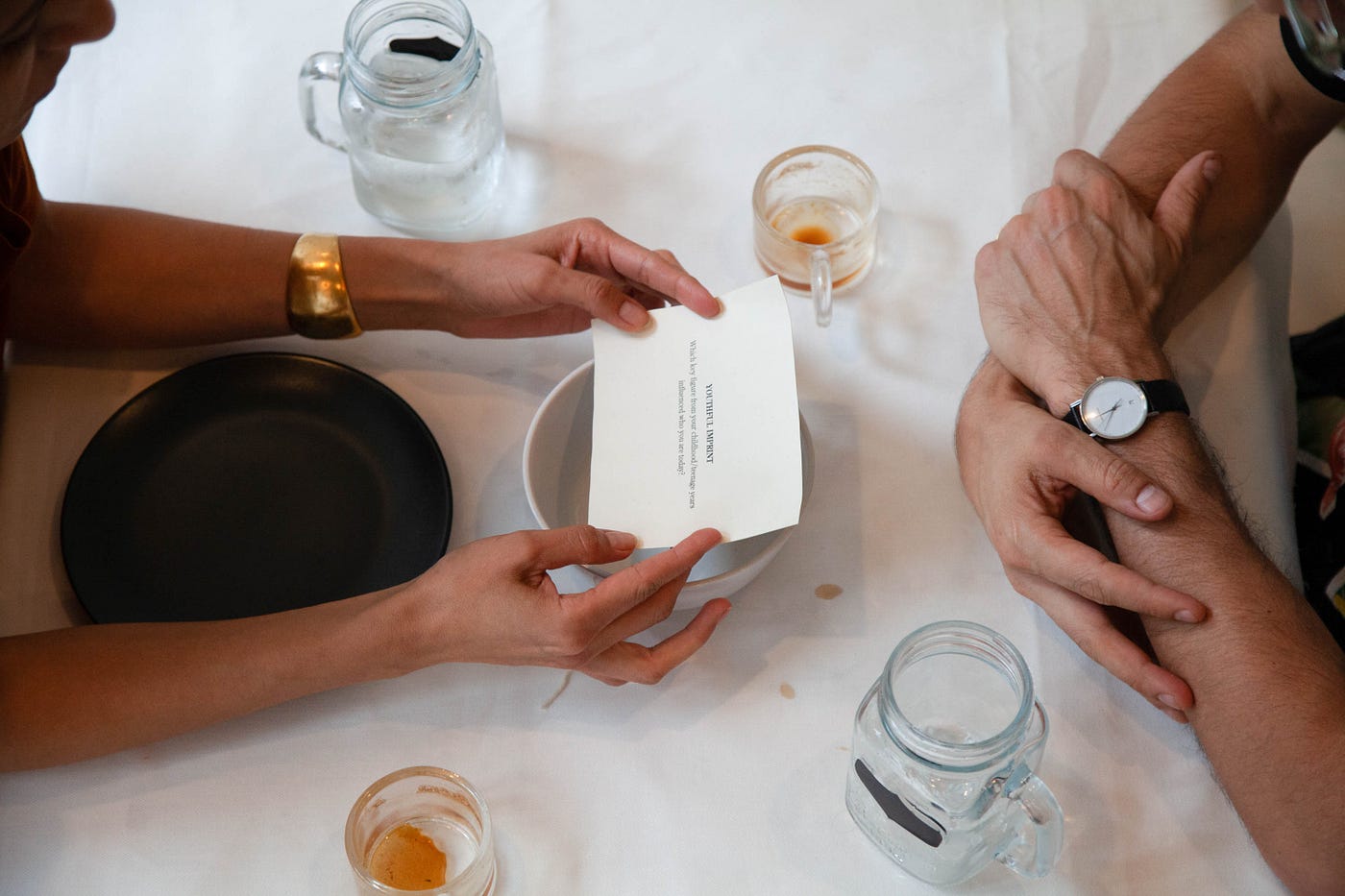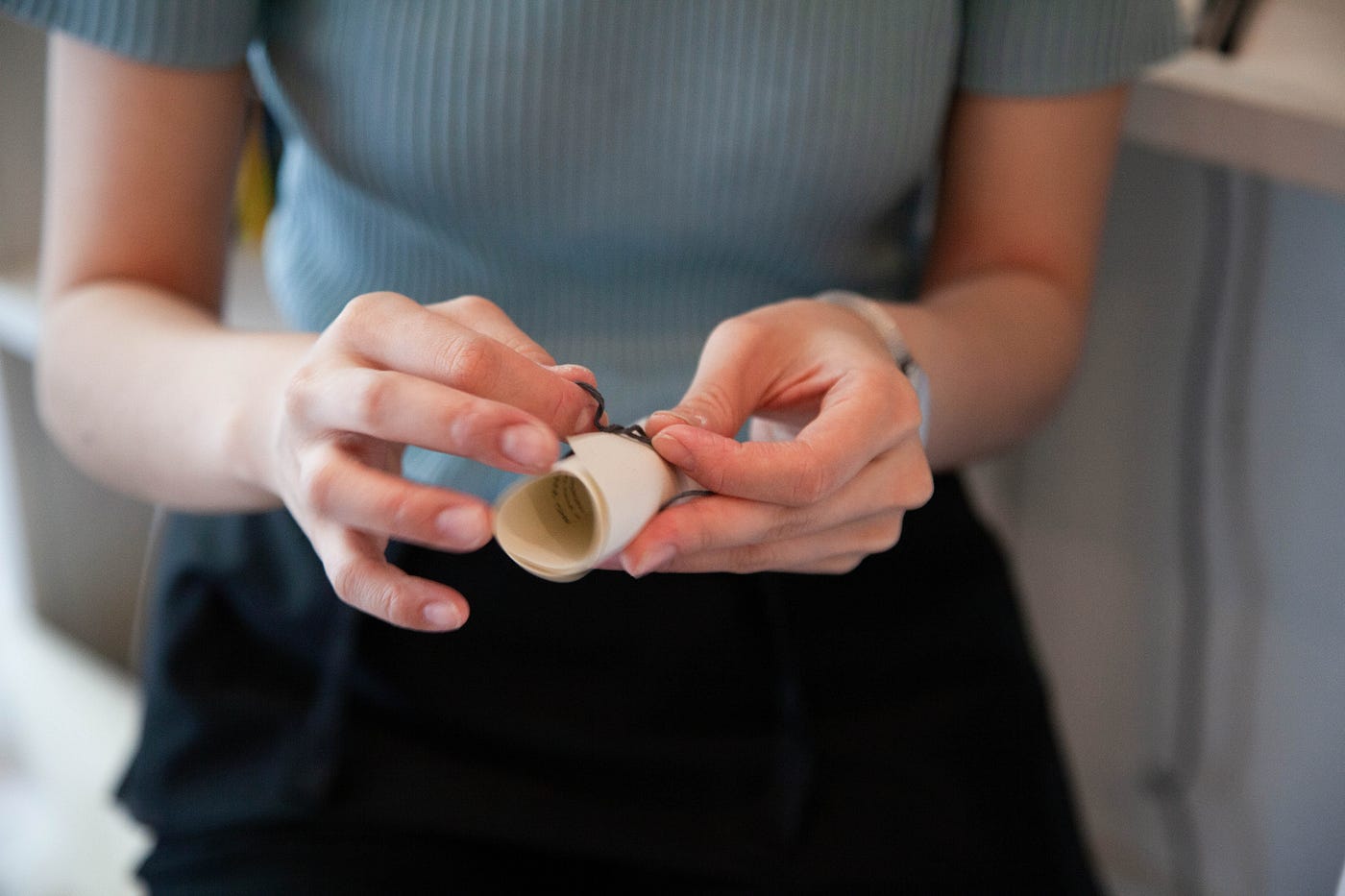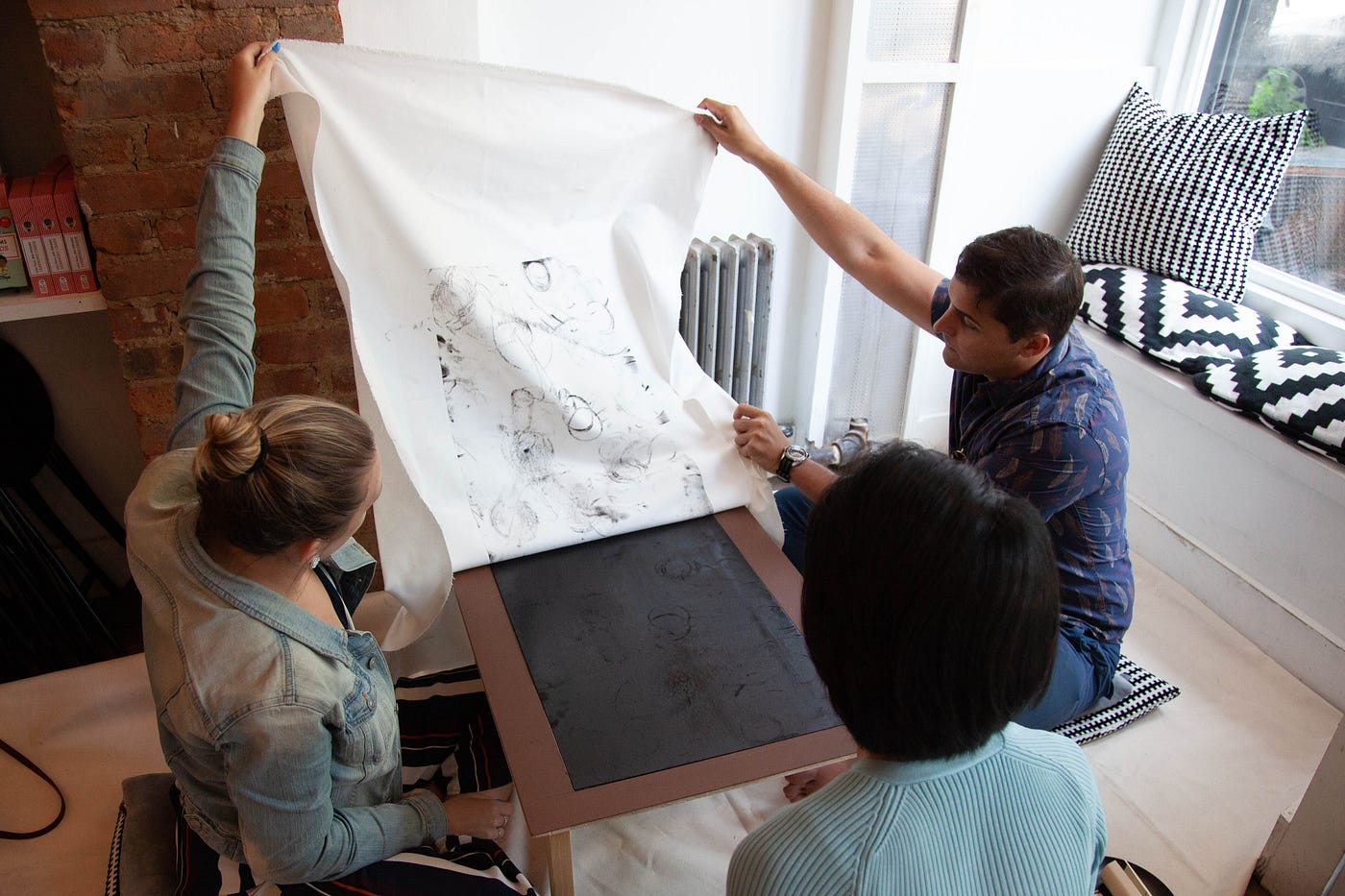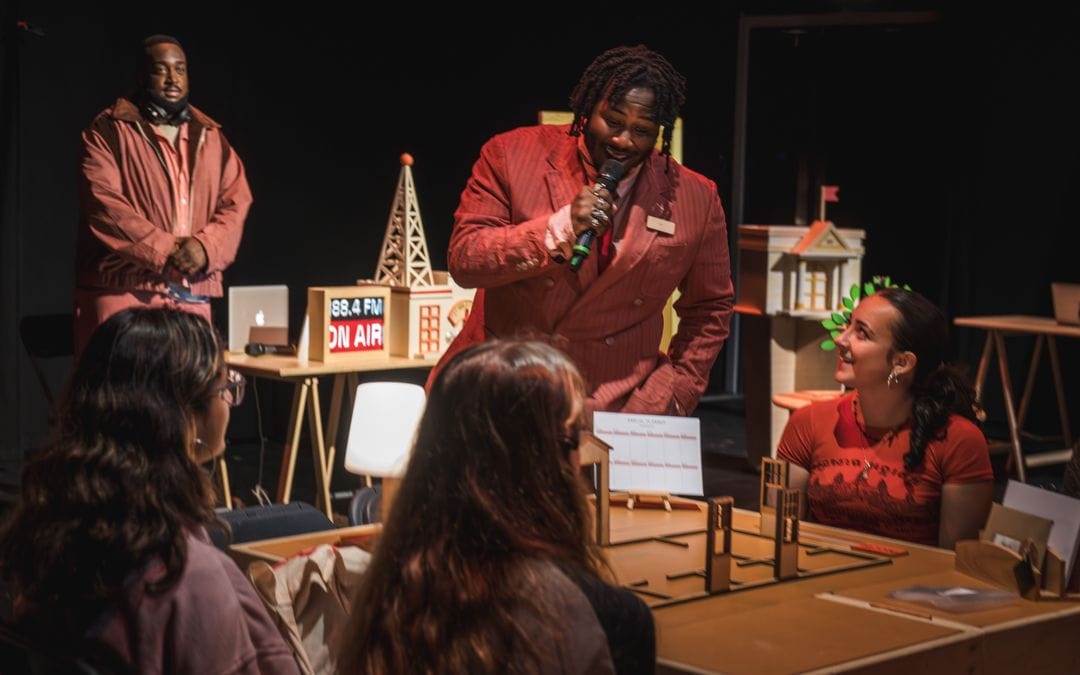
“As mankind grew obsessed with its hours, the sorrow of lost time became a permanent hole in the human heart. People fretted over missed chances, over inefficient days; they worried constantly about how long they would live, because counting life’s moments had led, inevitably, to counting them down. Soon, in every nation and in every language, time became the most precious commodity.”
I recall these words and they haunt my mind after stepping out of the cafe and back into the hustle and bustle of real life. This quote, from Mitch Albom’s The Time Keeper, a favored novel from my high school required reading days, resonates so deeply with me after my experience with Emily Kao’s Our Trace of Time. Time as a tangible object, as a gift, as a thing to be given, received, and taken away, and what we do in light of that recognition.
Our Trace of Time is an immersive dining experience that highlights, honors, and celebrates the giving of the gift of time from one person to another. Seeking to facilitate an intimate connection and exchange of meaningful conversation, this piece invites two “partners” (who ideally already share a history) to share the gifts of time and vulnerability with each other over an afternoon tea. The experience is facilitated by a waiter character who delivers conversation prompts to participants who are seated at a custom designed floor table. Posing the curated talking points as a three-course “meal,” participants are given two “appetizers,” one “entree” each, and one “dessert” to share. Ms. Kao herself plays the waiter, bringing over each “dish” and clearing away conversations past. Once the meal is finished, the participants are instructed to lift the tablecloth together, revealing a linoleum print of all touches and points of contact made to the table hidden on the reverse side of the cloth, a literal tracking of the time spent together. The resulting piece of visual art is a keepsake for the participants to take away with them to remember the experience and acts as a physical representation of the gift of time they have given one another.

Set in Crown Heights’ Cafe Con Libros, the experience mimics that of a coffee date, and for myself and fellow NoPro staff writer Michaela Holland, in particular, a gangly and meandering but wholesomely sweet first date. The floor table, designed by Kao, combined with the lush floor pillows, and the home-y atmosphere of the cafe create a solid sense of hygge, giving participants those warm and fuzzies usually only accomplished in front of a roaring fire. The tableware is beautiful — giant mugs for coffee and tea and a series of gorgeous bowls in which prompts are “served” create a thoughtful sense of curation. Specific attention has been paid to the integral role the dishes play in the experience and it shows. The coziness of the brick walls and soft lighting make it easy to begin to feel comfortable doing what is about to be asked of you, the enormous task of freely giving your time and emotional labor to another person.
Get Allie Marotta’s stories in your inbox
Join Medium for free to get updates from this writer.
SubscribeSubscribe
The experience is constructed for a pair of people who know each other well, but Michaela and I were able to navigate the conversation and fully participate in the event having only just met (in person) for the first time. The structure of the experience reflects that of the meal: the appetizer prompts whet the conversational palate and quietly compel participants to share in a genuine and vulnerable manner, asking “safer” questions concerning where we call home and why, and who we admire in our lives, both things that we can easily answer in a casual way. The entrees that follow are a bit heavier, asking for more emotional labor from the participants. Ideally, the entree prompts lead you to speak about the person attending the experience with you — your “partner” — and the shared memories you have. The dessert offers an opportunity to tie a lovely little bow on the moment, and your relationship, nudging you to highlight the light, love, and support found in your connection with your partner. Considering we had just met, Michaela and I spoke about our partners in the real world, which maintained the idea of the encounter but lost the intention. However, the prompts did serve as an incredibly touching way to get to know the essence of a new acquaintance quite quickly. We enjoyed sharing with each other and discovering our commonalities and differences in such a condensed but somehow effortless format. Over the course of a cup of tea and a croissant, our dynamic shifted from slightly awkward first date to catching up with an old friend.

The work Kao is developing is captivating, just brushing against the edge of what relational theatre aims to tackle. The idea of art as a state of encounter, as opposed to a fixed, package-able item, is the thesis which relational work is based upon. It’s looking to recreate everyday social situations under the lens of art and is revolutionary in the manner that spectators are permitted to participate in and affect the resulting performance. With revolutionary endeavors bursting the boundaries of just how personal performance can get, like Odyssey Works’ collection of biographical spectacle installations and Lance Weiler’s nuanced notes of autobiographical detail in Where There’s Smoke, it’s no surprise that this kind of highly intimate and personalized work is growing rapidly and with great force. Our Trace of Time checks nearly all the boxes of the newly developing genre, but seems to be lacking that actual aspect of performance. Cafe Con Libros is active and open to the public throughout the experience which diminishes the integrity of the piece. Customers bustle in and out of the front door which is located right next to the floor table, coffee machines whir about making espresso, and ambient conversation of other customers drowns out the piece’s soundscape, making the whole thing a bit awkward and forced at times. This is not to say that relational theatre can’t exist in public, it just felt like this specific piece was designed for some place a little more secluded. It felt strange to be talking about my deepest, darkest secrets as the entire neighborhood bore witness while getting their morning caffeine fix. Because of this environment, I felt exposed and distracted from the purpose of the event — connection.
The lack of a performative frame is also due in part to the role of the waiter. Kao’s portrayal of the waiter functioned quite similarly to that of an actual waiter as she interrupted the conversation from time to time to check in and move us along. I wonder what the purpose of having a live waiter as the facilitator of the experience is outside of pure practical functionality. Her role doesn’t seem to add anything to the piece and I wonder if the prompts could either be delivered without the use of a facilitator, or this “waiter” role could be made to have a more meaningful objective, which could perhaps add a way to set a more performative tone.
Another question to consider is whether this is “immersive” or not. Relational work tends to get lumped under the vague umbrella description of immersive due to its participatory nature, but it doesn’t always exactly fit. “Immersive” has come to mean anything that engages with the audience in an unconventional way, but in terms of more traditional immersive work that curates an environment for spectators to explore and engage with, I wouldn’t necessarily say that Our Trace of Time fits the bill. It’s more site-specific than immersive in this sense. Considering this in conjunction with the lack of actual performance, I wouldn’t feel right calling this immersive theatre, but rather a relational experience.

Despite the growing pains of location and some minor structural flaws, I commend the ambition of Our Trace of Time. It’s clear that the piece is onto something here, and in fact, we were pleased to hear that there are plans to further develop this concept, as Kao mentioned the possibility of a full meal pairing with each of the prompts in a future iteration. However, the successes of the piece are strong, and I would like to highlight the stunning moment of lifting the cloth off the table at its conclusion in particular. This reveal was remarkable and such a special moment. The concept itself — the surprise self-created documentation — is brilliant and innovative; this is the hero of the work. For a society obsessed with documenting memories (and, let’s admit it, low key obsessed with ourselves), this is the jackpot. The concept and physical design is where Our Trace of Time most succeeds, which makes sense considering that the bulk of Kao’s experience lies in visual art and design. I look forward to seeing how her work and this project will develop going forward and am eager to see how the worlds of visual and participatory art might cross in this vein of work in the future. The relational theatre scene is just starting to make its way into mainstream practice and Our Trace of Time is an exciting indicator of this progress, it’s only a matter of time before the opportunities to see ourselves as objects of art making come in abundance.
Our Trace of Time runs again on June 30. Tickets are sold out.
NoPro is a labor of love made possible by our generous Patreon backers. Join them today!
In addition to the No Proscenium web site, our podcast, and our newsletters, you can find NoPro on Twitter, Facebook, YouTube, Instagram, in the Facebook community Everything Immersive, and on our Slack forum.
Office facilities provided by Thymele Arts, in Los Angeles, CA.




















Discussion